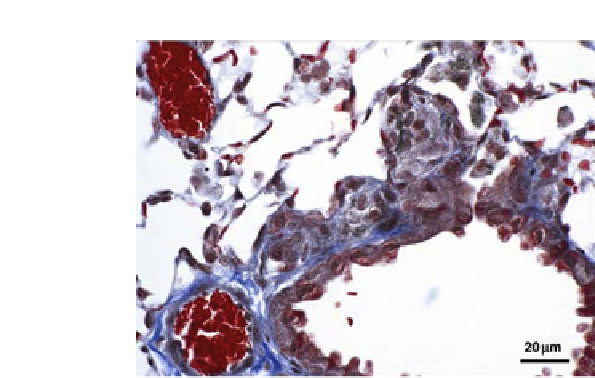Biomedical Engineering Reference
In-Depth Information
FIGURE 8.2
Representative image of lung section from the SWCNT inhalation study
(5 mg/m
3
, 5 h/day, 4 days) depicting granuloma formation on day 28 post-treatment. Fibrosis
is indicated by blue staining in this Masson's Trichrome stained section of the lung.
From
Shveda 2009. (For color version of this figure, the reader is referred to the online version of
this topic)
The C
60
type of CNTs, also called fullerenes or bucky balls have been syn-
thesized and their toxicity profile have also been investigated albeit not to a full
extent. Formed by a graphite arc process, sixty carbon atoms combine into a
stable spherical structure of twenty hexagons and twelve pentagons about 1 nm
in diameter. To create a solution of C
60
, it is suspended in the organic solvent tet-
rahydrofuran
85,86
or stirred in water over time.
87
The solid C
60
have been studied
by Oberdörster
88
who raised questions of potential cytotoxicity that had been
shown by other groups to be likely caused by the tetrahydrofuran used in pre-
paring the 30-100 nm particles of C
60
used in the research.
86,89
Isakovic et al.
89
gave studies that showed that removal of THF from the C
60
particles resulted
in a loss of toxicity.
89
Similarly, Sayes et al. (2007), showed that C
60
particles
instilled intratracheally in rats caused no detectable inflammatory response after
3 months of observation
90
using quartz particles as control, which resulted in
inflammatory response. Other studies indicated that nC
60
are toxic in human
fibroblasts and liver carcinoma cells,
86
human neuronal astrocytes,
91
and guinea
pig alveolar macrophages.
92
Studies with human skin cells showed a decrease in
viability at 24 h with an increase in nC
60
concentration.
93
These in vitro tests have
been used to conduct high throughput screening of nanoparticles (NPs) to help
understand the mechanism of cellular interactions as well as to minimize animal
use. The interactions of CNTs with cells in culture have been reported by many
investigators to determine their in vitro effects on different cell types. Studies in
human keratinocyte cells, HaCaT, and in human epidermal keratinocytes (HEK)
suggested that SWCNTs are toxic.
94
Unmodified MWCNTs within the cytoplas-
mic vacuoles of HEK resulted in decreased cell viability and a dose-dependent
increase in the levels of proinflammatory cytokine interleukin 8 (IL-8).
95

